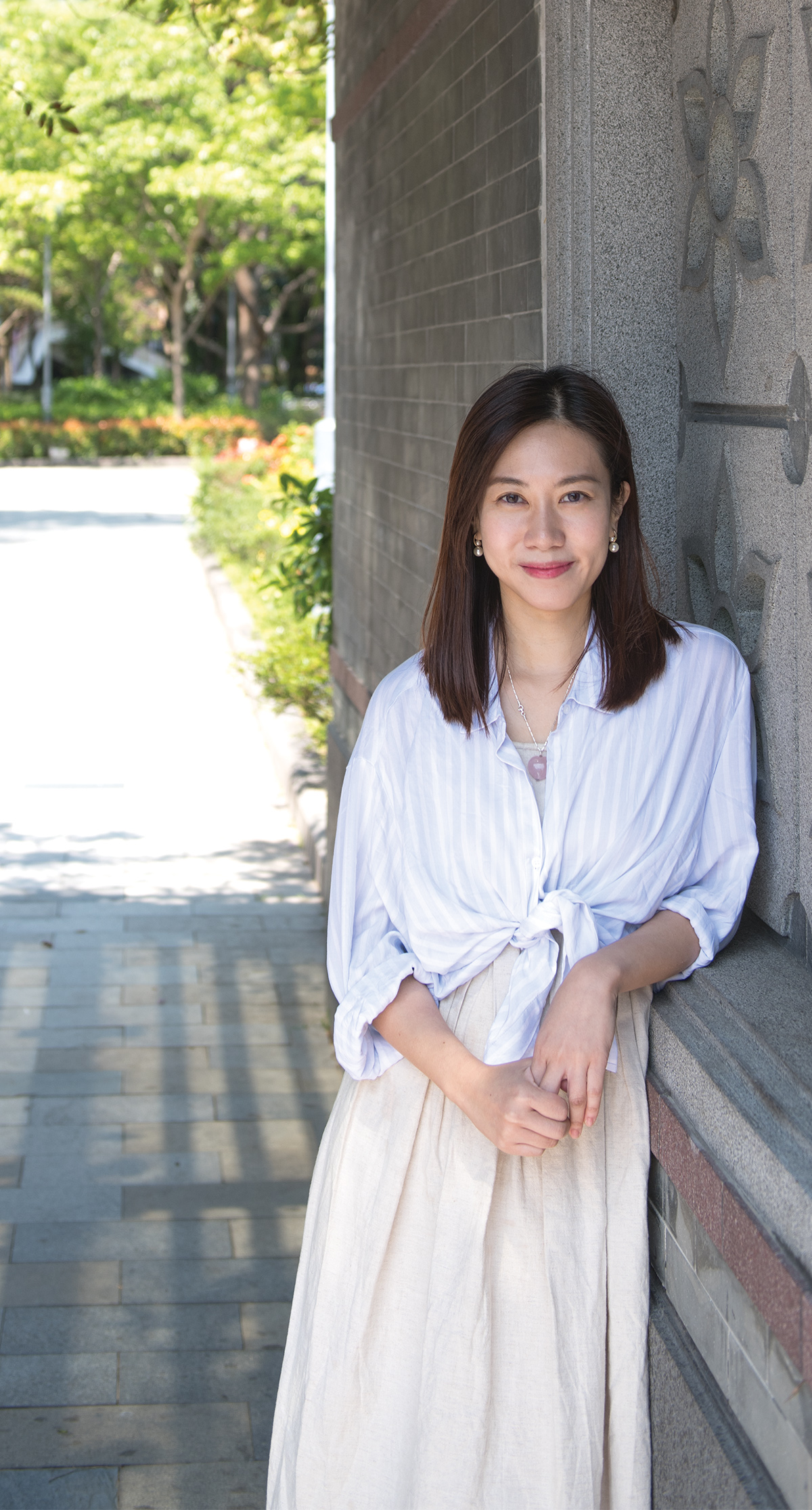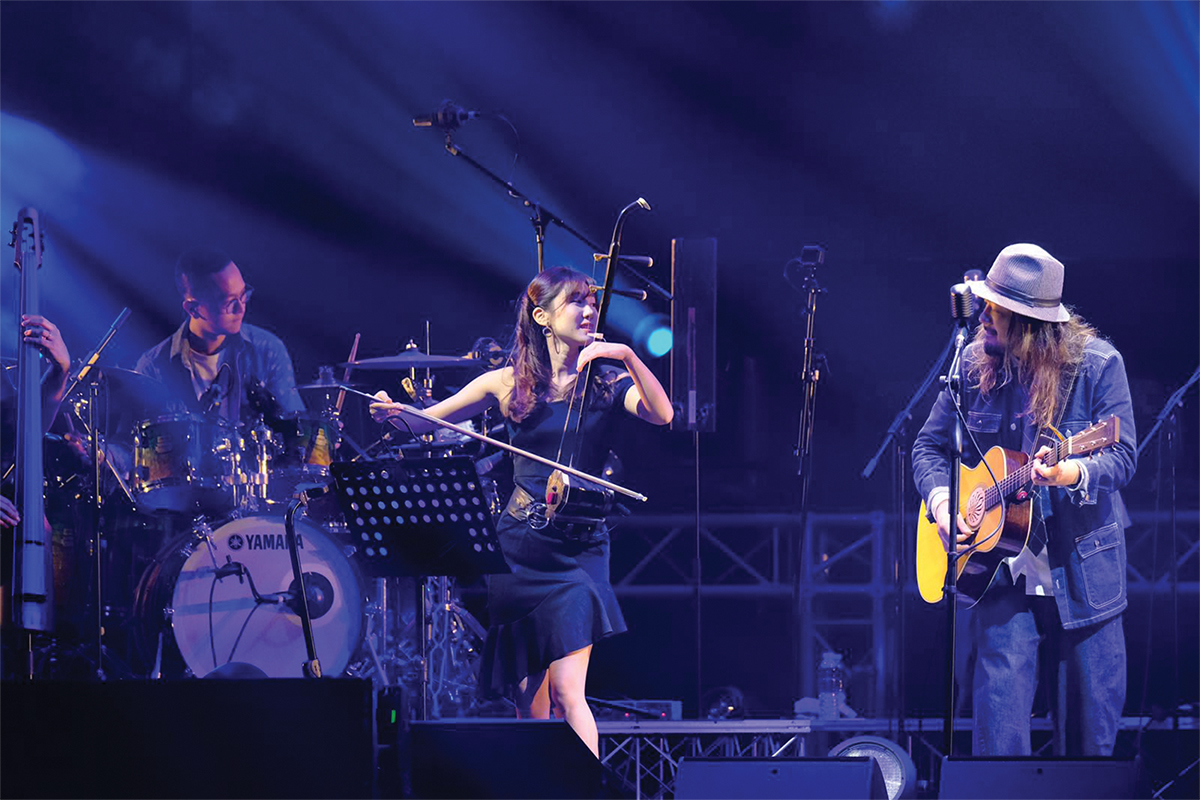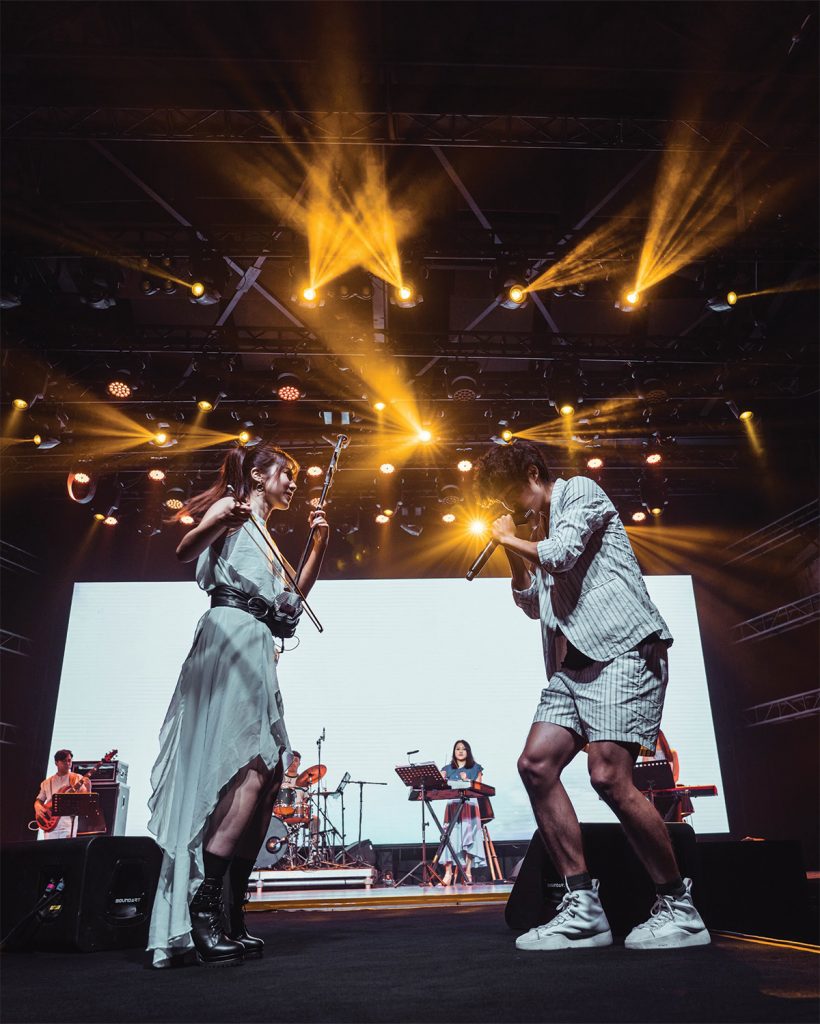Vantage Music | February 2020 | Hong Kong
Revival of Guangdong Music and Tradition as the Essence of Modern Music
In late February, amidst the concern over the coronavirus, we were fortunate to be able to invite erhu artist Chan Pik Sum (陳碧沁) for a phone interview. Active in both Chinese and Western music, Chan has performed worldwide with leading orchestras such as the Pan Asia Symphony Orchestra and the City Chamber Orchestra of Hong Kong. She has also served as concertmaster for the Academy Chinese Orchestra and the Hong Kong Youth Chinese Orchestra. Although the year did not have a promising start, with concerts having to face inevitable cancellations as a precaution against the pandemic, 2020 is still seeing the development of new projects for Chan as she plans to release two personal albums, which include collections of traditional and new crossover material.

Choice of Erhu and Early Development
When her mother brought her along to her older sister’s Chinese percussion lessons at the Music Office1, two-year-old Pik Sum was fascinated by the sound of the erhu coming from the room next door, where the man who would be the first teacher to initiate her into the erhu was teaching. As she was too young to sign up for lessons, Wong Shu Wing (黃樹榮), the erhu teacher, told her to come back when she had reached the minimum age of six. Chan still remembers her first lesson: “I became interested in the erhu right after the first lesson, where my teacher played a piece named ‘Xiao’ (簫), which is a well-known Chinese folk song that everybody had to learn as a beginner.” Although Chan did not come from a musical family, her parents have been very supportive of her decision to pursue a career in music. As the youngest daughter of the family, with much older siblings, Chan was not put under any pressure by her parents about what she should do for a career and she had their full support for whatever she chose. Practising the instrument was something fun for Chan and she didn’t need to be reminded to do it. She enjoyed playing the erhu so much that toys could not tempt her away from practice.1 The Music Office is managed by the Leisure and Cultural Services Department, which offers instrumental lessons to young people.
2 光明行 “Kwong Ming Hang” is a solo erhu piece composed by Liu Tian Hua (劉天華) in 1931. The piece is characterised by an uplifting, excited and vigorous tone that was a march used during the May Fourth movement in the style of the Han people, which is rare.
HKAPA and Encounter with Guangdong Music
Before entering the HKAPA, Chan had played at the their Chinese orchestra, which had been short of players. “I was in my fourth or fifth year of secondary school and, by playing in their orchestra, I started to understand what student life was like at the HKAPA.” By the time Chan graduated from high school, she applied to the HKAPA and began her performance studies there.
Chan Pik Sum studied both the erhu and gaohu as double major at the HKAPA under Professor Yu Qiwei (余其偉), who was to become a major influence in her development in Guangdong music. Chan has a high regard for Professor Yu: “If I were taught by other erhu professors back then, I wouldn’t have become the erhu artist that I am today.” Although she did not take to Professor Yu straight away, Chan was to find that he was very open-minded and had a liberal teaching style.
One important lesson that Chan remembers from her teacher is his emphasis on keeping the traditional side of music: “He calls it 雙肩挑, which literally means to carry on two shoulders, so you must maintain a good balance between traditional and new material in terms of the style of music you play.” Professor Yu also provided Chan with lots of performance opportunities, which built up her confidence when collaborating with different musicians.
In hindsight, Chan told us that she would like to have spent more time learning from Cantonese opera masters, which would have improved her grasp of the flavor of Guangdong music in her playing. “My teachers in their time would listen and imitate those who were playing traditional Guangdong music on the streets; but, for us, we don’t have this kind of environment.”
Chan Pik Sum is a beneficiary of the Helena May club, from which she received a scholarship in 2007 whilst studying at the HKAPA. Chan was nominated by the HKAPA: “I was the only female erhu player there then. I was concertmaster of the Academy Chinese Orchestra,” she said. The Helena May supports women in education, as well as the arts and cultural activities. Money from the scholarship funded Chan’s studies and enabled her to buy a new erhu.
An Introduction to Erhu and the Invention of Gaohu
The erhu is a two-stringed bowed instrument that belongs to the huqin (胡琴) family. Developed from the xiqin (奚琴) in north-east China, the erhu was initially a folk instrument played in southern China and first appeared during the Tang Dynasty. During the 1920s, Chinese musician-composer Liu Tianhua (劉天華) introduced the erhu to the capital, Beijing, where it became the most popular form of huqin in the country.
Making comparisons with the stringed instruments of the western world, the erhu is similar in pitch to the viola, despite being often compared to the violin, whilst the gaohu (高胡) matches the violin in this regard. Further down the line in terms of pitch is the gehu (革胡), which can be said to be the equivalent of the cello both in the sound and structure of the instrument, both having four strings in the same pitch of C-G-D-A and using a similar bowing technique. The contrabass gehu (低音革胡) functions as the Chinese version of the double bass.
The gaohu, developed and adapted from the erhu in Shanghai in 1920s by Chinese composer-musician Lü Wencheng (呂文成), was widely used to play Cantonese music and Cantonese opera. During the 19th century, Shanghai was a very westernized city and western music was played extensively in tea dances, cabarets and other entertainment venues using both western and Chinese instruments. Lü played the erhu but found the sound it produced too deep so he took the D string of the violin and fixed it onto the erhu, and minimized the size of the sound box. With these slight modifications, a brighter sound was attained and the instrument became what is now known as the gaohu. The first violin-maker in China, Mengyan Situ (司徒夢岩), assisted Lü in the manufacturing process and also taught him the violin. In fact, Situ studied mechanical engineering and ship-making; he learnt to play the violin as a hobby.
Violin pieces have been commonly used to train technical skills on the erhu, which can be very challenging. As the number of strings on an erhu is half of that on a violin, it makes it much more difficult to play as the hand has a greater distance to cover when pressing the strings. On top of traditional erhu music, to demonstrate technique when she was studying at HKAPA Chan had to play violin pieces adapted for the erhu, such as the Introduction and Rondo Capriccioso by Saint-Saëns and Zigeunerweisen (Gypsy Airs) by Pablo de Sarasate. “It’s very hard to play harmonics on the erhu,” she remarked.
There are other members in the huqin family, including the banhu (板胡) and jinghu (京胡), which are made from coconut shell or wood, and from bamboo, respectively. The banhu is played in bangzi (梆子) opera in northern China, whereas the jinghu often doubles the singer’s voice in Peking opera, imitating how the locals speak.
Notable Teachers
Huang An Yuan (黃安源), former concertmaster of the Hong Kong Chinese Orchestra, taught Chan fundamental performance techniques, whilst erhu and gaohu player Sarah He (何濤) was influential in Chan’s understanding of crossover material. Sarah and her husband, renowned suona player Guo Ya Zhi (郭雅志), played jazz and western music and have gone on to develop their performing career in the U.S.
Chan’s former teachers have all been performing musicians, which could be a factor that encouraged Chan to become a performer herself. “My first erhu teacher, Wong Shu Wing, has retired and does not perform any more; however, Professor Yu Qiwei is still active in the music scene.” Some of her teachers would attend Chan’s concerts from time to time to show their support, though sometimes it may not be so convenient for them to travel very far.
Cantonese Music
Guangdong music, also known as Cantonese music, was unpopular amongst the Chinese music circle because it was considered an old art form and was unorthodox; many preferred Chinese folk music, which was more mainstream. “Nobody in Hong Kong played traditional Guangdong music as everyone thought it’s old-school and was unfamiliar with it because no one taught them,” Chan said. “I was amongst the first cohort of young people who knew how to play this ‘old-school’ music.” But this makes it something special because it is rare to see the younger generation play local music.
Guangdong music was the most popular style of music in Shanghai at the time because of the thriving record industry, although, as its name suggests, it originated from the Guangdong cities of Hong Kong, Macau and Guangzhou. Music that was local to Shanghai, such as Jiangnan sizhu (江南絲竹), a type of chamber ensemble, and Peking opera, were not as prominent. A part of Guangdong music’s popularity across China came from Guangdong culture, which gave the impression that the local people enjoyed a relatively relaxed lifestyle as they perhaps suffered less hardship during the war. This life of the common people was reflected in their music, which was comparatively relaxed and easy to listen to.
Cantonese Naamyam 南音
Naamyam is a local narrative singing tradition in Cantonese, performed before the first half of the 20th century by blind singers at places such as teahouses, restaurants, brothels and opium dens. It was sung by the blind because some members of their audience, such as the prostitutes at the brothels where they performed, did not want to be seen. Moreover, as the singers were often hired by wealthy households to sing at their homes, the men wanted to ensure that their wives could not be looked upon.
The music of naamyam consists of a single tune which the singer adjusts to the pitches and sounds of the Cantonese dialect. One well-known naamyam singer of today is Cantonese opera performer Yuen Siu Fai (阮兆煇). Naamyam songs are lyrical in nature and follow literary texts, which have a common theme of lamentation for lost love. As the songs tend to be quite long, the singer would adapt the stories and improvise. Some of the instruments that accompany the singing include the zither (guzheng, 古箏), the lute (yehu, 椰胡), dulcimer (yangqin, 揚琴), and percussion instruments such as wooden clappers. Unlike western chamber music, for instance, there is only one set of music and no separate parts for each instrument, therefore they would have to improvise on the given melody. For example, if the gaohu and dulcimer were playing together, the dulcimer may adapt the melody by spreading it out in larger intervals or by adding other material.

Chan appeared as a guest performer in Jun Kung’s concert (2019). Photo credit: Johnny Yim

In 2019, Chan and harmonica virtuoso CY Leo were invited to perform in a concert organized by HKSAR’s Chengdu Economic Trade Office in China. Photo credit: Isaac Woo
Performances and Collaborations
In 2015, Chan performed with the a cappella group Yat Po Singers in a concert series named “Sounds of the South”. She has also collaborated frequently with harmonica virtuoso CY Leo (何卓彥) on arrangements of Chinese music and others, including music for violin such as Vivaldi’s “Winter”, which they have performed several times. Cellist Tan Cong (譚聰) is another musician who would appear in Chan’s concerts, such as the series “Beyond Boundary, Beyond Time” in January last year.
Local artists would be invited by ambassadors to perform in their countries and Chan was one of the artists appointed by the Hong Kong Economic and Trade Offices to promote Guangdong culture. She has performed in various locations, such as Singapore, Bangkok, Chengdu and Kazakhstan, as well as European countries including France, Belgium, Germany, Austria and the Netherlands.
During Chinese New Year in 2018, Chan was invited as one of the performing guests along with CY Leo to play at the Hong Kong-Thailand Trade Association Chinese New Year celebration dinner. This was arranged through the Home Affairs Bureau in conjunction with the Leisure and Cultural Services Department.
Last October, the Pan Asia Symphony Orchestra invited Chan Pik Sum to perform the world premiere of the symphonic poem “HoiShan – My Hometown” (交響詩 “我的故鄉 – 海韻之城”), composed by Dr Yip Wai Hong (葉惠康博士). The piece was intended as an erhu concerto and the concert took place at Shatin Town Hall and Tuen Mun Town Hall. This marks a breakthrough for the erhu as a solo instrument as, previously, there had been only traditional erhu pieces arranged for western orchestra but not new music written independently for the instrument. This opens the door to opportunities for future commissions of original works for the erhu, which has the potential to popularize the instrument. “It is important to promote classical music, or erhu, or any other kind of music that is not popular through performance because even people who are unfamiliar or have no knowledge in the field would come and listen.”
Challenges as a Professional Musician
The most imminent challenge is ensuring that there are enough concerts to remain financially stable. The recent coronavirus situation is a difficult test for this, and maybe more so for Chan as she relies on performing and does little teaching. In addition, a musician must maintain the quality of his/her performance and always have new material prepared. “Audiences can get bored of crossover material more easily than traditional music because what’s once new will become old very quickly in this day and age of fast-changing trends.” This proves the importance of keeping traditional music as it doesn’t seem to be affected by time, whereas new material requires constant renovation and reflection.
An equally demanding component of the work of a professional musician is packaging their performances. “The performing part actually takes up less than half of our time; the main part is finding concert opportunities,” Chan explained. Unlike pop artists, for instance, classical musicians often do not have managers to plan shows for them, unless they have the financial resources to hire a marketing team. Therefore, musicians need to put themselves in the position of the audience and consider whether what they plan to perform will be well received.
Teaching Experience and Advice for Young Musicians
In recent years, Chan Pik Sum has received invitations to talk about Guangdong music and to give demonstrations of traditional erhu music at schools. She has found that students enjoy Guangdong music almost as soon as they hear it, perhaps because the music itself reminds us of the Cantonese dialect. “Not many people who play the erhu teach or play Guangdong music in Hong Kong,” Chan said. “So my job is to let students know of its existence.” Chan felt that she bears part of the responsibility to promote Guangdong music and to enhance people’s understanding of it because it is a local tradition that should not be lost. Chinese instruments such as the erhu also have a disadvantage in an increasingly westernized society like Hong Kong. Chan told us that she has seen children who initially had a preference for the erhu being told that they should learn the violin instead, as parents believe that western instruments are of a higher class. “I think their ability to know what kind of sound they like is inborn,” Chan said. “I would advise students to go with the instrument that they like out of intuition.”
With regard to learning methods, two aspects were highlighted: selective listening and slow practice. The convenience of recording and the availability of online channels such as YouTube could make it more difficult for students to focus as they can find many versions of the same piece. “When choosing one style of playing over another, you must be very clear about the reasons for your choice,” Chan remarked. Secondly, students perhaps spend too much time trying to achieve a high level of technical skills, at the expense of refining their playing style. Traditional music, which tends to be slower in pace, is particularly useful for training good timbre but young students often lack the patience required.
For those who would like to pursue a career as a professional erhu player, Chan stressed again the importance of preserving traditional music, as it is the core foundation from which crossover material is conceived. One must have a good, solid understanding of what is unique about the sound of the erhu so that it retains its value in collaborations. Working with a range of different artists is essential for any kind of performer as you improve and develop your skills through these interactions. “Great players don’t just come from within HKAPA,” Chan told us; “there are foreign players who I got to know at bars in mini bands who are excellent players.”
Projects for 2020
Some adjustments have had to be made to Chan’s concert schedule for February and March because of the coronavirus: “I should be in Singapore right now but the concert was cancelled,” she told us. “I was supposed to be touring in the Greater Bay Area in April but now it’s unlikely that it would go ahead.” Though it may not be possible to hold concerts as before, Chan was lucky that her show, “Secretly Hers”, with “Gig in da sky” sponsored by the Affectionate World Charitable Foundation (人間有情慈善基金), had the chance to be broadcast live through social media such as Facebook Live, IG Live and YouTube Live on 2 April. Singers Sukie Shek (石詠莉) and Rachel Lau (劉蘊晴) also featured in the show.
With concert plans disrupted due to the coronavirus, Chan has turned her attention towards preparing for a CD release, which will be her first solo album. She plans to record two separate CDs, one for Guangdong music and another for crossover material. “A producer invited me to make a Hi-Fi CD and I was given a lot of freedom for what I would like to put on it but I haven’t thought it out in detail yet.” Some of the considerations include deciding on the style of music and selecting the combination of instruments that will be used so that listeners can find a connection between the pieces. Chan also mentioned that she wanted to avoid being too eclectic in the crossover material that she chooses to feature on the CD. We wish her a smooth recording process and look forward to hearing her latest works.
Interview written by Puntid Tantivangphaisal

